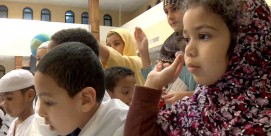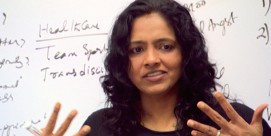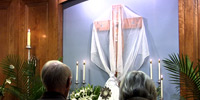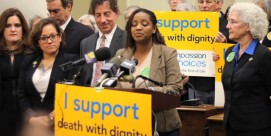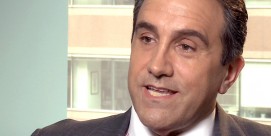In This Episode << SLIDE LEFT TO SEE ADDITIONAL SEGMENTS
Lourdes 150th Anniversary
BOB ABERNETHY, anchor: We have a special report today on Lourdes. For Catholics, it’s the most popular pilgrimage site in the world, after the Holy Land. Sick people go to Lourdes hoping for miraculous cures. But the attraction goes beyond physical healing. All those we talked with — the sick and the well — said they had a profound spiritual experience. Our correspondent is Don Kladstrup.
DON KLADSTRUP: It is, in many ways, a spectacle: a spectacle of faith, of devotion, a place of suffering — and of hope. Father Jim Martin:
Father JAMES MARTIN (Author, “Lourdes Diary”): People are drawn here for many reasons — for physical healings, but also just to get closer to God, in a place with a great community of believers.
Sister NOREEN FALCONE (President, Order of Malta, Washington, D.C.): This is a pilgrimage. We are on a pilgrimage here for a week. But our whole life is a pilgrimage, to someone of faith.
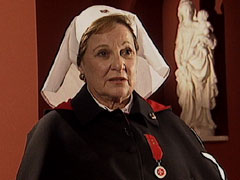 Noreen Falcone |
KLADSTRUP: On a winter day in 1858, Bernadette Soubirous, a 14-year-old peasant girl, was gathering firewood near a grotto when she saw an apparition. Afterwards, Bernadette would describe what she saw as simply “a lady in white.”
People today associate Lourdes with miracles, where healings occur and illnesses are overcome. But over the last 150 years, during which time more than 200 million people have come to Lourdes, only 67 miracles have been confirmed by the Catholic Church.
Fr. MARTIN: Well, you could say only 67 or as many as 67. I think that, you know, people have been drawn to Lourdes not only for the miracles but also because it’s a place of great faith.
KLADSTRUP: Thousands of people have claimed to be cured here. But the Catholic Church does not certify a miracle unless the affliction was incurable and the cure was both unexplainable and permanent.
Every day, 30,000 gallons of water flow from the spring. The water goes into a system of nearby spigots where visitors drink from it, wash with it and carry it home. It’s described as a symbol of devotion. Although chemical analysis ascribes no special properties to it, some people aren’t so sure.
NICOLE DIGKMAN: I had a car accident a few months ago. And I have a whiplash. And yeah, I’m hoping it will be — it will get better.
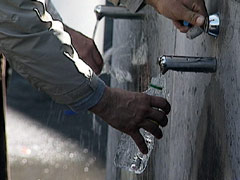 Water from Lourdes |
KLADSTRUP: The seriously ill who come here are known as the “malades” — French for “the sick.” A Catholic humanitarian group, the Order of Malta, brings malades here for a week every year, along with companions and helpers. Noreen Falcone is president of its Washington, D.C. association.
Sr. FALCONE: They are hoping that they’re going to have a miracle — that they’re going to be miraculously cured by going to the waters and to the grotto and asking the Blessed Mother for a miracle to make them well again. Our mission is more to give them support and to hope that they come to terms with their illness.
KLADSTRUP: The domain of Lourdes, as it’s called, covers a large area adjacent to the town. There are 22 places of worship, the centerpiece being the Basilica of the Immaculate Conception. Another basilica — this one underground — seats 25,000. Volunteers escort the malades through the sprawling grounds in carts in order to conserve their strength. Matt Coles is 24. Though never a smoker, he has stage four lung cancer.
MATT COLES: It’s such a blessing to be here, especially with my wife and son.
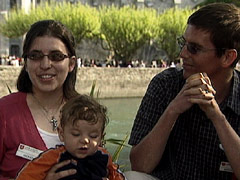 Coles family |
LUCY COLES: It’s just such a peaceful place, and to be able to come here with Matt, and be part of this and have a healing experience whether it’s spiritual or physical.
KLADSTRUP: Ray Troup came with his 12-year-old son Joe. Troup lives in constant pain due to nerve damage in his lower back. He can’t stand, or sit, for any length of time without severe muscle spasms.
RAY TROUP: I came here to ask God for healing so that I can better support my family. And if it not be his will, then I’m just asking for the grace to get through each day.
KLADSTRUP: Stacy Persichetti is a Georgia woman with two small children. A year and a half ago, she was diagnosed with a malignant brain tumor.
STACY PERSICHETTI: One day you think that you’re just fine and everything’s going along and then the next day, you know, I was told that I had, you know, a level — a grade three cancer and that I’d have 12 months to live.
KLADSTRUP: After lengthy treatment, the cancer was gone. For Stacy, this is a pilgrimage of thanksgiving — and of hope that the cancer won’t return.
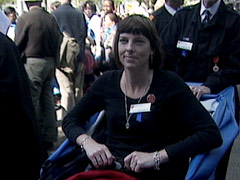 Stacy Persichetti |
Lourdes is a town of 17,000 people, nestled in the foothills of the Pyrenees, near the Spanish border. Six million people come here every year. Hundreds of hotels, restaurants and shops line the narrow streets. The souvenir stores specialize in statuettes, rosaries and containers for the spring water. They are not allowed inside the domain, which is only a few steps away. Here, the atmosphere is one of reverence. People line up to pass through the grotto where the apparition took place. Noreen Falcone:
Sr. FALCONE: When you go over to the grotto and you look at the faces of the people who have come here, you see faith so strong in the eyes of these people.
KLADSTRUP: The stone, touched by hopeful hands for 150 years, worn to a shine. Father Jim Martin …
Fr. MARTIN: There’s a sense of holiness, of not only being in a place where something important happened, but also being in a place where 150 years of pilgrims have come and run their hands over that same place.
Ms. PERSICHETI: It was such a powerful moment — the fact that a year and a half later I have no cancer when one doctor had told me that I was going to be dead by this point. Such a miracle to me. And there’s been so many miracles, not only physical but also spiritual miracles that have occurred here.
KLADSTRUP: After passing through the grotto, Ray Troup knelt in prayer with his son.
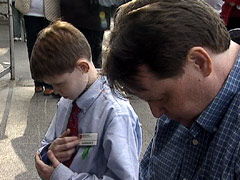 Ray Troup and his son Joe |
Mr. TROUP: It’s tangible. All my concerns, all my worries — everything just left. You could just pray so intensely and so easily. It was such a wonderful experience.
UNIDENTIFIED PRIEST (saying prayer): So, as we begin this pilgrimage let us pray, asking the Lord, “Lord bless this candle, which is the sign of faith, of light in our hearts. When we are discouraged, give us light. Help us to see the light of the eternal life that you promised us.”
KLADSTRUP: The words of the apparition to Bernadette, “Go to the spring and bathe there,” are followed by many thousands of those who come here.
Sr. FALCONE: People that come here believe if they bathe in the waters, they’re going to, that’s where the miracle would begin. It has happened. It doesn’t happen every time. It is a cleansing, but it’s a cleansing of your mind as well.
KLADSTRUP: There are 11 pools for women, six for men. Photography inside is strictly forbidden.
(to visitor Patricia Walker): How did it feel to be there?
PATRICIA WALKER: It felt — well it was exciting.
KLADSTRUP: Was it what you expected?
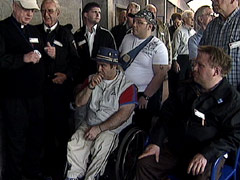 Waiting to bathe in the pools |
Ms. WALKER: I didn’t know what to expect. But it was pleasant and it was cold.
D. J. CAREY: It was moving, very moving, very spiritual, enlightening and just kind of euphoric.
KLADSTRUP: Bernadette said the apparition told her, “Have the people come here in procession.”
Fr. MARTIN: In Catholic theology, after the celebration of the mass, they reserve what’s called the Eucharistic host, which we consider the real presence of Jesus. And so that’s processed through the street as a way of people coming into contact with Jesus in that way. And it’s a very ancient tradition that goes back to medieval times. And it’s really very popular in Lourdes.
KLADSTRUP: At a special mass during their pilgrimage, the malades and others are anointed. The anointing of the sick is a sacrament in the Catholic Church.
Fr. MARTIN: Through symbols like oil and the laying on of hands, we communicate what the Apostles asked us to do, which is to pass on Christ’s healing power.
KLADSTRUP: Ray Troup:
Mr. TROUP: During the sacrament of the sick, right after the anointing, all of a sudden I was just filled with joy. Since I’ve been here I’ve grown in prayer, patience, peace. I’ve already received a miracle as far as I’m concerned.
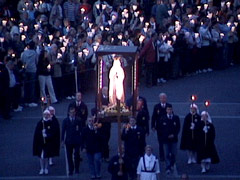 A procession of torches at night |
Mr. COLES: It’s quite possible that I’ll have cancer for the rest of my life …
Ms. COLES: I think the miracle …
Mr. COLES: … and that’s OK.
Ms. COLES: … has already happened, and just allowing us to come here. And I think our faith will only be strengthened by the presence of all these people — by the presence of Mary having come here. And I don’t think that we could — we could ask for anything more.
KLADSTRUP: As night falls on the domain at Lourdes, the torchlight procession begins. Father Jim Martin describes it as an expression of popular devotion.
Fr. MARTIN: People say the rosary all together, in a procession with the malades and their companions and visitors. And they sing Marian songs and hold candles, not only as a way of illuminating the darkness, but also as a symbol of their faith. In most of the world, the people who are poor and sick are ignored. In Lourdes, they are number one.
KLADSTRUP: Noreen Falcone has been to Lourdes 12 times.
Sr. FALCONE: It never gets old. It never gets old. Wellness of body is not really what our life here on this earth is about. It’s really about wellness of mind, wellness of heart, wellness of soul.
KLADSTRUP: Stacy Persichetti:
Ms. PERSICHETTI: When you experience Lourdes, even if you never came for a physical healing, I don’t think that you can come away from it without being a changed person.
KLADSTRUP: For Religion & Ethics NewsWeekly, this is Don Kladstrup, at Lourdes.

